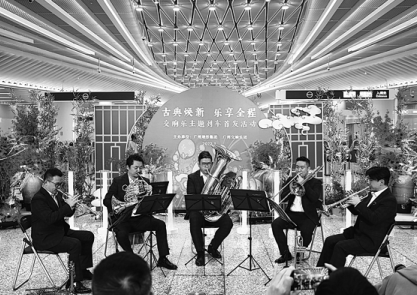Innovative ensembles adapt to life during the pandemic
Classical works woo subway passengers and zoo visitors
Commuters waiting for a train at one of the largest subway stations in Guangzhou, Guangdong province, a week before Spring Festival listened as a brass quintet played live.
On Jan 24, passengers at Panyu Square Station on Metro Line 18 stopped to take photos of the ensemble of musicians from the Guangzhou Symphony Orchestra and also learned that classical music would be played in the station from that day onward.
The orchestra and the Metro announced that the city's first subway train themed on classical music would operate from Jan 24 to the end of next month.
Decorated with cartoon images of composers and the 12 animals of the Chinese zodiac, the train offers passengers a range of classical repertoire.
Chen Qing, the orchestra's president, said, "All passengers need to do is scan a code with their phone to enjoy classical music pieces and learn about the composers, musicians and conductors."
He added that it took several months to launch the special train, and that the recordings are all performed by the orchestra.
According to Chen, the Chinese zodiac design was adopted for the train to welcome the Chinese Lunar New Year, with 12 classical composers and their works chosen based on the zodiac cycle.
For example, one of the works offered to passengers is Concerto No.5 in E flat major, Op. 73, also known as The Emperor, by German composer Ludwig van Beethoven, who was born in 1770, the Year of the Tiger according to the Chinese zodiac. This version of the work is performed by the Guangzhou Symphony Orchestra under the baton of Yu Long, and featuring pianist Chen Sa.
Other pieces in the project include Piano Concerto No. 2 in F minor, Op. 21 by Polish composer Frederic Chopin, who was born in 1810, the Year of the Horse. This work is performed by the Guangzhou orchestra conducted by Grammy Award-winning John Nelson, with Yuja Wang the soloist.
There is also Symphony No. 5 by Austrian composer Gustav Mahler, born in 1860, the Year of the Monkey, which is performed by the orchestra under the baton of Huang Yi, and Voice of Spring Waltz by fellow Austrian Johann Strauss II, who was born in 1825, the Year of the Rooster, again performed by the orchestra, conducted by Zhang Guoyong.
Chen Qing said, "The aim is to bring classical music to people who would normally never have the opportunity to hear it in the concert hall."
Since the orchestra was formed in 1957, it has taken part in numerous recordings featuring top musicians from around the world, he added.
"We love to share our repertoire with the public. Whether they are going to work, back home or meeting up with friends, passengers can have a good time on the train. It is scientifically proven that classical music can be a powerful tool for relieving everyday stress. We hope that this project will make their day more relaxing," Chen Qing said.
Over 7 million passengers a day use Metro Line 18 in Guangzhou, and the collaboration between the orchestra and the subway operator will last for three years, he added.
More projects themed on classical music will be launched for the public, bringing the art form to a wider audience.
This is not the first time the orchestra has brought classical works out of the Xinghai Concert Hall, its home since 1998.
Since 2017, the orchestra has collaborated with Canton Tower-the 600-meter-tall Guangzhou landmark designed by Dutch architects-to broadcast pieces performed by the ensemble, which have been warmly received by local residents and tourists.
The tower overlooks Baiyun Mountain, the Pearl River, and offers a panoramic view of the city. Classical works from different eras by composers such as Johann Sebastian Bach, Wolfgang Amadeus Mozart and Antonin Dvorak are played at the location every day.
Last year, to mark the third anniversary of Baiyun International Airport's Terminal 2 being put into operation, the terminal worked with the Guangzhou Symphony Orchestra to bring classical music to passengers via the airport app and sound systems in the departure and arrival halls.
"A city should have a symphony orchestra, which provides classical music to engage and inspire audiences of all ages," said Chen Qing, who has worked with the Guangzhou orchestra for 30 years. "An orchestra also grows and develops with a city.
"We are happy to see that classical music audiences in Guangzhou are becoming much more diverse and younger. The same is true for many Chinese cities."
Celebrating its 65th birthday this year, the Guangzhou Symphony Orchestra gives about 100 concerts annually, including those provided to audiences for free and also low-priced performances. According to Chen Qing, it is the first and only Chinese symphony orchestra to play on five continents.
On Feb 3, 2020, the orchestra stopped performing live due to the COVID-19 pandemic, and next day, it launched online music programs. For more than 100 days, the orchestra updated its online music program every day, before returning to the concert hall for a live performance on July 7, 2020.
Chen Qing said, "COVID-19 has radically changed our experience of classical music. Before the pandemic emerged, we announced our performance seasons annually. Tickets sold out fast, as we have a loyal fan base in Guangzhou. Now, classical music is less elitist, as concerts are available just like any online movie, which has allowed us to reach new audiences.
"This inspired us to think about the relationship with our audiences. We've observed their needs and we want more people to enjoy classical music."
On Dec 12, the Xi'an Symphony Orchestra, conducted by Jing Huan, performed a concert titled The Afterglow of Romanticism at its concert hall in Xi'an, capital of Shaanxi province.
Featuring violinist Wang Zhijiong, the orchestra performed works such as Polonaise from Eugene Onegin, Op. 24 by Pyotr Ilyich Tchaikovsky and Violin Concerto in D, Op. 35 by the United States composer Erich Wolfgang Korngold.
Eleven days later, a citywide lockdown was imposed in Xi'an in an effort to curb a resurgence of COVID-19 cases.
Guo Rui, brand manager for the Xi'an Symphony Orchestra, said: "It was our last concert before the lockdown, but we never expected the city to remain closed for a month. With all the experience we'd gained in the past two years, we stayed calm and quickly came up with online programs."
Founded in 2012, the orchestra has recruited musicians from around China, most of them younger than 30. In 2020, it used creative ways to engage with audiences as live concerts were canceled due to the pandemic. For example, it streamed a series of concerts online, combining classical music with artworks displayed at museums in Xi'an, which attracted millions of viewers.
To bring classical music closer to the public, the orchestra performs outdoor concerts annually at the iconic Big Wild Goose Pagoda in Xi'an, a Buddhist structure built during the Tang Dynasty (618-907).
Xi'an has a proud history and is no stranger to music, such as folk works and Qinqiang Opera, an ancient high-pitched operatic style. Guo said that since the orchestra was formed, it has built a close relationship with audiences, bringing a different artistic aspect to the city.
The orchestra gives a new year concert annually, but this year the performance had to be switched to online platforms. Chinese-Australian conductor Dane Lam, the orchestra's principal conductor, was scheduled to return to Xi'an from Australia for the concert.
Lam said: "After 28 days' quarantine, we had to cancel the performance, which was very sad. But it's a time when we can come together and reflect on the past year and make plans for the year ahead. We still want to present a sense of togetherness to get us through these tough times."
On Dec 31 and Jan 1, Lam led the orchestra in an online concert that featured Beethoven's Ode to Joy from the composer's ninth symphony-one of three online performances on the two days.
Guo said members of the orchestra also served as volunteers during the city's lockdown, taking shifts day and night to deliver daily necessities to residents in communities.
On Jan 25, the orchestra announced its performance season for this year, with the theme "Under the Same Sky".
"It is our tenth season and also our first since the lockdown, which is very special for all of us," Guo said, adding that 15 concerts are scheduled, featuring veteran conductors such as Tan Dun, Lin Daye and Huang Yi, and soloists including classical guitarist Yang Xuefei, pianist Zuo Zhang and violinist Gao Can.
"Now, our lives return to normal and we will resume our concerts," Gao said.
On Feb 3, the orchestra and its chorus gave a virtual concert, attracting audiences to outdoor venues in Xi'an during Spring Festival.
Musicians performed at Xi'an Qinling Wildlife Zoo and at Jingzhuang Resort, home to Tang Dynasty-styled gardens.
With animals and natural scenery forming the backdrop, musicians performed works that included Once Upon a Time in the West by Italian composer Ennio Morricone, Carnival of the Animals by French composer Camille Saint-Saëns, and The Spring Festival Overture by China's Li Huanzhi.
Unlike the West, China is new to the classical music world, and is considered a significant market that holds the key to the genre's future.
Many Chinese children are studying instruments such as the piano, violin and cello, while local governments are investing in building new music halls. The public, especially younger audiences, are also showing keen interest in classical works.
An increasing number of orchestras are being formed, in addition to established ensembles such as the 140-year-old Shanghai Symphony Orchestra.
During the past eight years, rather than performing in concert halls, the Sichuan Liangshan Mountain Symphony Orchestra, based in the Daliangshan Mountain area of Liangshan Yi autonomous prefecture in Xichang, Sichuan province, has been routinely holding outdoor concerts, with the mountain as a backdrop.
Conductor and composer Tang Qingshi, the orchestra's president, has spent this time popularizing classical music among audiences in the Daliangshan area.
Chen Guangxian, director of China's Symphony Development Foundation, a nonprofit organization, said the number of symphony orchestras nationwide has grown considerably in recent years. In 2014, there were about 30 professional symphony orchestras in the country, but now there are more than 80.
"We often say that art changes life. A symphony orchestra provides not only entertainment for the public, but also plays an important role in art education," he said.
In 2016, Chen Guangxian founded the Suzhou Symphony Orchestra in Jiangsu province, gathering musicians from nearly 20 countries and regions, including China, the United Kingdom, Japan, South Korea and the US. Now, 70 percent of the orchestra's members are non-Chinese.
Suzhou has a rich history that boasts time-honored art forms such as ping tan, an ancient Chinese form of singing and storytelling that dates back 400 years, and Kunqu Opera, one of the oldest forms of Chinese opera, which is more than 600 years old.
"The orchestra has brought diversity to the city," Chen Guangxian added.

The Guangzhou Symphony Orchestra performs at the city's Panyu Square Station on Metro Line 18. CHINA DAILY
Copyright © Foreign Affairs Office of Guangzhou Municipal Government,
Hong Kong and Macao Affairs Office of Guangzhou Municipal Government All rights reserved.
Presented by China Daily.
京ICP备13028878号-28



